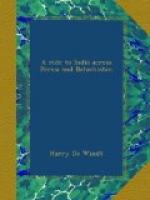The environs are not picturesque. They have been likened to those of Madrid, having the same brown calcined soil, the same absence of trees and vegetation. The city, viewed from outside the walls, is ugly and insignificant, and, on a dull day, indistinguishable at no great distance. In clear weather, however, the beehive-like dwellings and rumbling ramparts stand out in bold relief against a background of blue sky and dazzling snow-mountains, over which towers, in solitary grandeur, the peak of Mount Demavend, [A] an extinct volcano, over 20,000 feet high, the summit of which is reported by natives to be haunted. The ascent is gradual and easy, and has frequently been made by Europeans.
Teheran is divided into two parts—the old city and the new. In the former, inhabited only by natives, the streets are narrow, dark, and tortuous, leading at intervals into large squares with deep tanks of running water in the centre. The latter are characteristic of Persia, and have in summer a deliciously cool appearance, the coping of the fountain being only an inch or so in height, and the water almost flush with the ground. The new, or European quarter, is bisected by a broad tree-lined thoroughfare, aptly named the “Boulevard des Ambassadeurs,” for here are the legations of England, France, and Germany. The Russian Embassy, a poor building in comparison with the others, stands in another part of the town. Hard by the English Embassy is the Hotel Prevot, kept by a Frenchman of that name, once confectioner-in-chief to his Majesty the Shah. Here we took up our quarters during our stay in the capital.
At the extremity of the Boulevard des Ambassadeurs is the “Place des Canons,” so called from the old and useless cannon of various ages that surround it. The square is formed by low barn-like barracks, their whitewashed walls decorated with gaudy and rudely drawn pictures of Persian soldiers and horses. Beyond this again, and approached by an avenue of poplar trees, lit by electric light, is the palace of the Shah, with nothing to indicate the presence in town of the sovereign but a guard of ragged-looking, unkempt Persians in Russian uniform lounging about the principal gateway.
The Persian soldier is not a credit to his country. Although drilled and commanded by European officers, he is a slouching, awkward fellow, badly paid, ill fed, and not renowned for bravery. The ordinary infantry uniform consists of a dark-blue tunic and trousers with red facings, and a high astrachan busby with the brass badge of the lion and sun. To a stranger, however, the varied and grotesque costumes in which these clowns are put by their imperial master is somewhat confusing. One may see, for instance, Russian cossacks, French chasseurs, German uhlans, and Austrian cuirassiers incongruously mixed up together in the ranks on parade. His army is the Shah’s favourite toy, and nothing affords the eccentric monarch so much amusement as constant change of uniform. As the latter are manufactured in and sent out from the countries they represent, the expense to the state is considerable.




